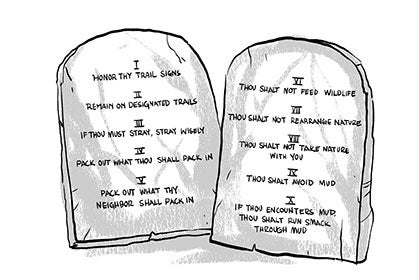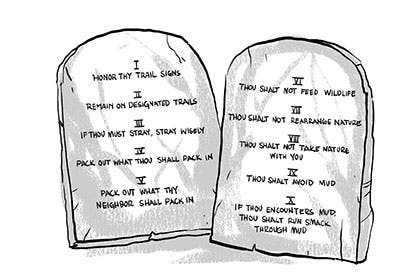The 10 Commandments of Trail Preservation

Courtesy of VeloPress
Republished with permission of VeloPress from Trailhead: The Dirt on All Things Trail Running by Lisa Jhung, with illustrations by Charlie Layton. For more, visit velopress.com/trail.
Trails are gifts that keep on giving. By making preservation efforts, we ensure that our grandchildren’s grandchildren can enjoy wonderful trail-running adventures, too. Here are 10 handy and important guidelines about how you can do your part to preserve nature, excerpted from Chapter 9 of Trailhead.
I. Honor thy trail signs.
Trail signs are posted for a reason (or three), and those reasons involve preserving the trail, preserving the natural habitat of the trail, or keeping the peace among trail users.
Honor and obey these signs. Ignoring them not only puts the peace at risk but also puts the trail at risk for being closed to runners and other users. Land managers don’t like it when their signs are ignored.
II. Thou shalt remain on designated trails.
Unless you need to leave the trail to do some business (and even then, see Commandment III), you should stay on designated trails. Occasionally you may be tempted to bushwhack off trail to check out a view, take a shortcut, or look for wild raspberries. Keep in mind that doing so puts the natural habitat at risk (and that plants often whack back).
Remaining on the trail also means not cutting corners—don’t beeline straight up or down a hillside instead of following the switchbacks. Doing so can damage the area.
III. If thou must stray, stray wisely.
If you do bushwhack, travel on the hardest, most durable ground you can find—rocks, logs, woody plants, or dry grasses. Avoid stepping on fragile flora such as moss, lichen, and alpine plants. These plants take an exceptionally long time to recover. If you bushwhack in a group, don’t run single file. Spread out to minimize repeated footsteps over a single area. And choose a different route on your way back to the trail—doing so will minimize impact.
IV. Thou shalt pack out what thou hast packed in.
Also known as “Pack it in; pack it out,” this principle means Don’t litter on the trail. Do your due diligence in not leaving behind the tops of gel packets, corners of energy-bar wrappers, or toilet paper. Other trail users deserve a trash-free nature experience, and garbage left on the trail can harm wildlife.
V. Thou shalt pack out what thy neighbor hast packed in.
This is more than just a good deed. By shoving a wayward gel wrapper in your pack, you’re bettering your environment and that of everyone around you.
VI. Thou shalt not feed wildlife.
You are not doing that cute chipmunk, emaciated deer, or chirping marmot any favors by sharing your food. Feeding human treats to wildlife endangers them in more ways than one: Your food could make them sick or change their behavior.
Say you feed a chipmunk. Word spreads among his friends that there are energy bars down by the trail. Many chipmunks start coming near the trail. The chipmunks start fighting for energy bars, injuring each other. Or a coyote gets word of the party and comes down to prey on the chipmunks.
The human-animal feeding relationship lessens an animal’s natural fear of people, a fear that is necessary for both animal and human safety. Animals can become more aggressive toward humans when they learn to expect handouts.
Finally, feeding animals brings a higher concentration of animals to a particular area, which can help spread diseases among them.
VII. Thou shalt not rearrange nature.
Although a downed log or a slew of babyhead* rocks may be a nuisance to navigate around, leave them be. The trails are likely the way they are for reasons of sustainability: minimizing erosion and encouraging healthy water drainage. Plus, other trail users, such as mountain bikers, are sometimes attached to natural features even if they seem like obstacles.
*ba·by·head rock ‘bā-bē-hed ‘räk n. (pl. –s) 1. Smooth, roundish rock shaped and sized like a baby’s head.
VIII. Thou shalt not take nature with you.
It is very tempting to pick a bouquet of wildflowers; grab a giant, heart-shaped boulder; or bring home a stick shaped like a light saber for your kid, but refrain. Leave nature behind for everyone to enjoy in his or her own way.
IX. Thou shalt avoid mud.
Avoid muddy trails. Running on muddy trails damages the trail, with your footprints splattering the surface at every step. On a rainy day (or season), that means either finding a well-draining trail, sticking to the roads (or treadmill) for your run, or seeking out a dry trail.
Fellow trail runners in your area can help you figure out which local trails have the best drainage and therefore are the least muddy. Try calling a running or an outdoor store for tips and insider information.
X. If thou encounterest mud, thou shalt run smack through it.
Should you encounter a muddy section of a trail, either turn around and go another way or run through the middle of the trail. Stepping off to the side widens the trail and causes more damage to the habitat than does traipsing right down the middle.
Trailhead is a witty, fun guide to all things trail running. Veteran trail runner, triathlete and adventure racer Lisa Jhung offers this illustrated pocket guide to all runners curious about running off road or wanting to run farther into the backcountry. She offers authoritative advice on everything from how to find good trails to run, how to choose the best shoes and clothing and how to carry enough water to how to stay safe from wildlife and weather.
